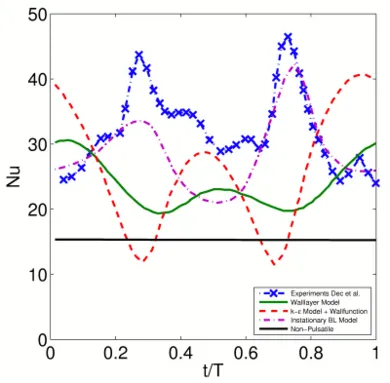Enhanced Heat Transfer in Self-Excited Pulsatile Flows
by T. Holzinger and Wolfgang Polifke
Motivation and Background
The decreasing size of microchips leads to critical material temperatures. The power density of computational hardware units is increasing steadily. Most of the energy is directly transferred to heat which has to be removed from the chips surface by either active or passive cooling systems. Due to this fact heat transport is a size limiting factor for some high-end computer elements like CPUs etc. The removable amount of heat depends on the surface area, the temperature difference between surface and fluid, and the instant flow conditions. Each of these three dependencies leads to a different concept, which is capable of avoiding this limitation:
- Increasing the surface area by mounting cooling fins or needles
- Amplifying the temperature difference by either pre-cooling the flow media or allowing higher material temperatures of the hardware modules.
- Improving the heat transfer coefficient by modifying the fluid flow or materials characteristics
While material and form optimization have been exhausted to the utmost, the latter of these points still carries a lot of potential, which is partially not investigated.
Research Goals
Some typical forms of fluid flow manipulation are heat pipes (utilizing the enthalpy of evaporation) or artificial enhancement of turbulent structures by fins or swirlers. Compared to the enhanced Nußelt number in higher regimes of turbulence the increase by creating a pulsatile flow can be orders higher. The idea of this project is to set up the pulsatile flow by superposing an acoustic oscillation on a steady flow. In this case the acoustic power shouldn't be produced by an active driving mechanism but converted from the heat flux. This heat flux conversion is typically done by thermoacoustic engines. Using this feature, the heat transfer itself exites a fluctuation that again causes a higher heat flux density. The developing limit cycle improves the cooling efficiency without producing higher costs. Milestones of the research project are stabilitiy analyses of thermoacoustic engines, the development of a numerical model of the enhanced heat transfer and the setup of a test engine that shows up enhanced heat transfer effects.
Theory
Enhanced Heat Transfer in Pulsatile Flows
Almost twenty years ago Dec and Keller discovered the effect of highly enhanced heat transfer rates in the tail pipe of a pulse combustor. The length of the tail pipes are adapted to the combustion process for creating an acoustic standing wave in the vicinity of the first eigenmode. This pressure wave causes a higher pressure level in the instant of the combustion, and is therefore suspected to reduce NOx in the exhaust gas.
Investigations of the dimensionless heat transfer, the Nußelt number, showed an temporal increase to about three times the stationary value (compare the blue and black line in Figure 1). As you can estimate from the diagram, the time averaged heat transfer rate is also twice the origin.

The basic mechanisms of this effect are not identified so far, although a lot of suggestions were made. Additionally most of the numerical simulation types do not display a sufficient realistic behavior heat transfer in pulsatile flows.
Thermoacoustic Engines and Refrigerators
Commonly, talking about thermoacoustics, the interaction of combustion and acoustics are observed, but the research filed is much wider: any interactions between acoustics and thermal inhomogeneities causes thermoacoustic phenomena. This definition also includes pure flameless systems, like the Rijke and the Sondhauss tube. A further class of such devices are thermodynamic refrigerators and engines that manage to convert heat into acoustic power at a point A, transport it with the speed of sound to point B and release it there . Due to the nature of this process refrigerators of that kind are able to cool a certain area and release the power at room temperature without using any moving parts (except of the membrane of the driving speaker). On the other hand, a system with a certain temperature gradient may become instable and convert heat flux to acoustic power. Those systems are commonly known as thermoacoustic engines that work on either travelling or standing waves (like the one in the scheme below).

The physics of such devices are described by equations set up by Rott et al. and described by Swift. The conversion mechanism is based on the phase lag of a particle caused by the thermal and viscous boundary layer of the stack.
References
[1] Dec, J.; Keller, J. & Arpaci V., Heat Transfer Enhancement in the Oscillating Turbulent Flow of a Pulse Combustor Tail Pipe, Int. Journal of Heat and Mass Transfer, 1992, 35, 2311-2325
[2] Thyageswaran,S. Numerical Modeling of Pulse Combustor Tail Pipe Heat Transfer, International Journal of Heat and Mass Transfer, 2004, 47, 2637-2651
[3] Rott N. et al., Damped and Thermally Driven Acoustic Oscillations in Wide and Narrow Tubes/ Thermally Driven Acoustic Oscillations II-VI, Zeitschrift für Angewandte Mathematik und Physik (ZAMP), 1969-1983, Springer Verlag
[4] Swift G., Thermoacoustics - a Unifing Perspective for some Engines and Refrigerators, Acoustical Society of America, 2002